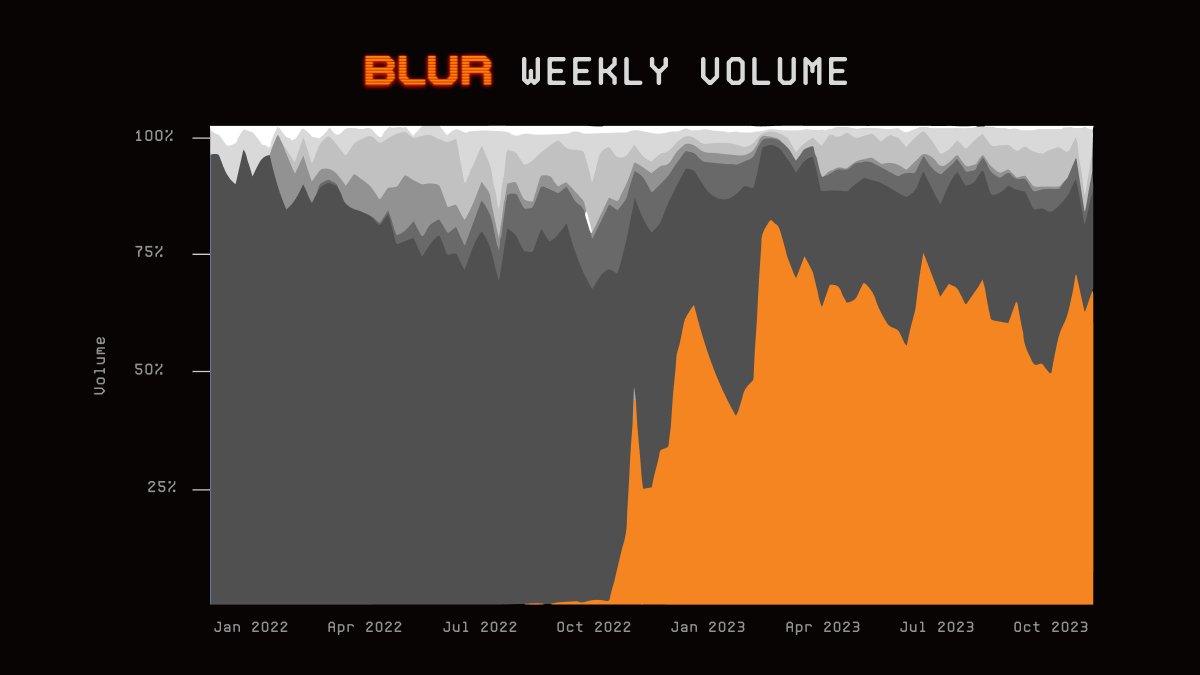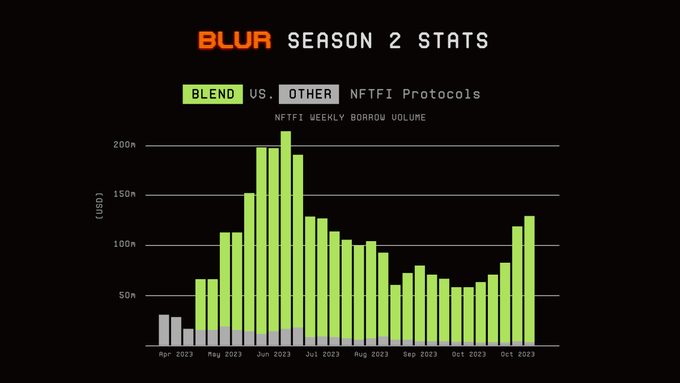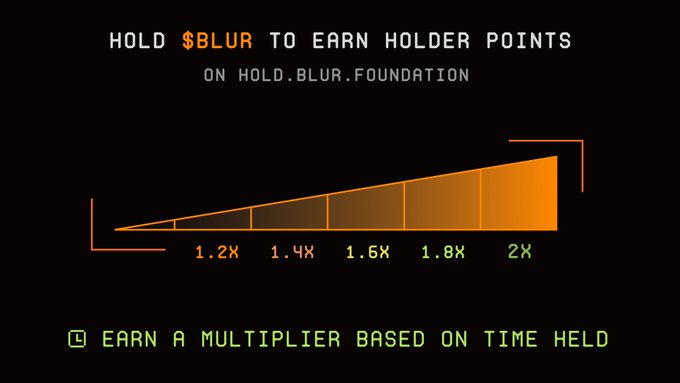In the early morning of November 21, 2023, the NFT community woke up again when Blur airdropped to users on its platform and planned to launch L2 Blast as well as continue to deploy Blur Season 3. So, details about L2 What’s special about Blast and what opportunities do we find in Blur Season 3? Let’s find out with Weakhand in this article.
- What is Blur? Blur cryptocurrency overview
- What is Blend? Perpetual Lending Protocol for NFTs
- What is NFT Marketplace? Operating mechanism and some prominent NFT Marketplaces
- Blur V2 with the ambition to change the game in the NFT market
Blur Overview
Blur is an NFT Marketplace Aggregator on Ethereum designed for professional traders. Blur aggregates data from many different NFT exchanges such as: OpenSea, LookRare, X2Y2,… so that users can trade NFTs in just one place at the best price.
Blur was launched in October 2022 and quickly rose to become one of the leading NFT Marketplaces on Ethereum. Blur’s goal is to build a platform that is equitable and empowers the community. BLUR token holders (the platform’s main token) can participate in governance decisions, earn rewards, and access exclusive features.
Blur’s Plan With Blur Season 3
Blur Season 2 officially ended on November 20, 2023, Blur still proves its strength as a leading NFT Marketplace with a cumulative trading volume of up to 6.1B USD, accounting for 65% of the market share and attracting up to 260,165 users in its Season 2.

Blur Weekly Volume
During this time, Blur also launched Blend – an NFT lending protocol integrated right on Blur. Since then Blend has also shown its superiority compared to other NFT Lending platforms in the market with over 90% market share maintained over a long period of time since its launch.

Blend dominates the NFT Lending market
To continue the current success, Blur Season 3 has officially started on November 21, 2023. In particular, Blur Foundation has cooperated with Blast – a Layer 2 supported by Paradigm and Standard Crypto to distribute airdrops to the community in this Season 3.
Blur Season 3 will last 6 months and end in May 2024, rewards will be divided equally between Blur holders and NFT traders on Blur meaning 50% will go to Blur Holders and 50% will go to Traders. on Blur. Details on how to earn points in Blur Season are as follows:
Earn points based on Bidding Point
- This is a mechanism that allows users to bid on NFT collectibles and points will be awarded based on the 24-hour trading volume of that NFT collectible.
- In each collection, if a user bids closest to the floor price, he will receive the most points i.e. if an NFT collection has a floor price of 1.01 ETH and 100 users bid at 1 ETH . If you bid at 0.99 ETH you will not earn more Blur Points than the other 100 users but if you bid at 1.01 ETH you will earn more Blur Points than the other 100 users.
- The longer a bid is active, the more points the user earns, and when the bid matches a market order, points are stopped.
- Some eligible collections allow users to bid on features within that NFT collection as well.
Earn points based on Listing Points
Listing Point will work differently than Bidding Point. Here are some ways to earn Listing Points on Blur:
- The more NFTs a user lists, the more Listing Points they receive.
- Listing Bluechip NFTs allows users the opportunity to earn more Listing Points.
- Use the Listing tools provided by Blur such as: Listing by floor price, price floor characteristics and ladder list.
Earn points based on Lending Points
In this Blur Season 3, Lending Points are only half that of Listing Points and Bidding Points (there is no longer a 2x multiplier for any NFT collections applied in this Blur Season 3). There are two factors that determine the number of Lending Points a user earns based on:
- Max Borrow: Represents the maximum amount of ETH a user can borrow using NFTs as collateral.
- APR: This is the % of money the lender earns from its approved loan offer.
The higher the Max Borrow rate and the lower the APR, the more Lending Points the user earns. Users can also make multiple Loan Offers on the same collection with different Max Borrow and APY and earn points for all of them.
For example: If the floor value of the collection is 10 ETH, the user can make an offer with a maximum loan of 9 ETH, 50% APY and another offer with a maximum loan of 5 ETH, 20% APY and earn points for this entire offer.
Earn points by becoming a Blur Holder

Hold Blur to earn Blur Points
Your multiplier starts at 1x and increases by 0.5x every month after the user makes their first deposit. Reward recipients in Blur Season 2 start with a 2x multiplier. If the user withdraws, the multiplier will decrease proportionally to the amount the user withdrew.
Note: The lowest multiplier is 1x, even if the user withdraws his entire amount of Blur tokens.
What’s Special About Blur’s L2 Blast?
Continuing the airdrop activity for Blur Season 2 and the latest scoring rules in Blur Season 3, Blur also announced the launch of a Layer 2 on Ethereum called Blast. According to information posted on Blast’s Twitter on November 21, 2023, they successfully called for 20M USD from Paradigm and Standard Crypto to build their Layer 2.
Introducing Blast: The only Ethereum L2 with native yield for ETH and stablecoins.
We’ve raised $20m from @Paradigm and @StandardCrypto to build the L2 that helps you earn more.
Details on how to get early access at the end of the thread
pic.twitter.com/AYYmK8YFx4
— Blast (@Blast_L2) November 20, 2023
Blast is built to promote ecological Staking on Ethereum. Users can deposit their ETH into Blast to earn an interest rate of 3 – 4%/year through Staking activities. In addition, the same is true for Stablecoins: when users Stake USDC, USDT and DAI on Blast, Blast will send it to T-Bill protocols such as MakerDAO and profits will be transferred back to Blast users via USDB – Blast’s auto rebasing stablecoin. With the above form of Staking using Stablecoin, users can earn a higher APR than Staking ETH up to 5%/year.
Blast also said it will apply Optimistic Rollups technology similar to Optimism and Arbitrum with EVM compatibility allowing investors and dApps on Ethereum to easily connect and deploy on its Blockchain. Blast’s development team includes: Pacman – founder of Blur NFT Marketplace along with an experienced team who has worked at MakerDAO, MIT, Yale and Seoul University.
In addition, Blast also applies the Blast Point scoring mechanism in which users can earn points based on the amount of Bridge money from Ethereum to Blast as well as the number of people invited to experience this Layer 2. The airdrop amount will be divided into 2 phases in which 50% will be distributed to early users and the remaining 50% will be for dApps to develop their products on Blast.
summary
With so much information coming in today, the Blur community is really excited. With the implementation of L2 Blast, it is likely that in the future Blur will move to this Layer 2 and this will greatly reduce users’ NFT transaction costs on Blur. Above is all the information that I want to introduce in this article, hope everyone has received useful knowledge.


